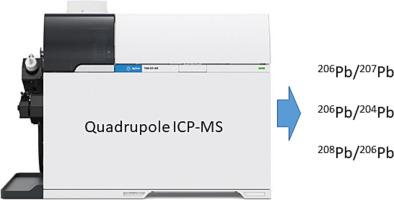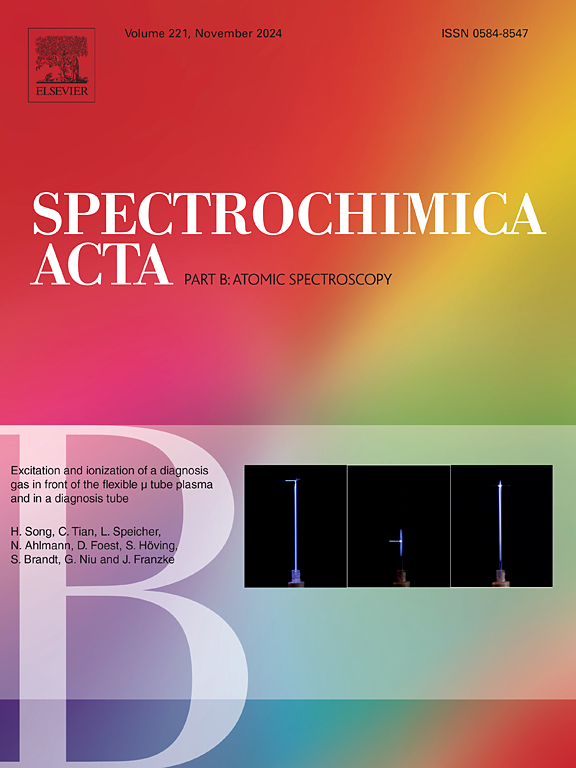ICP-QMS for lead isotopic analysis: Method development and key parameters
IF 3.8
2区 化学
Q1 SPECTROSCOPY
引用次数: 0
Abstract
This technical note demonstrates the potential of inductively coupled plasma mass spectrometry with a quadrupole analyzer (ICP-QMS) for lead isotope ratio determination offering a step-by-step guide for laboratories aiming to achieve reliable precision without access to multi-collector instrumentation. Key instrumental parameters such as dwell time, number of replicates, sweeps per replicate, pump speed and nebulizer gas flow were systematically optimized. Special attention was given to the influence of detector mode selection (Auto vs. Analog) and its impact on low-abundance isotopes such as 204Pb. The optimized procedure yielded precision of 0.08–0.10 % RSD for 206Pb/207Pb and 208Pb/206Pb ratios and 0.10–0.12 % RSD for 206Pb/204Pb as a minimum, which is sufficient for selected applications. The optimized method was validated using NIST SRM 981 and archaeological metal samples previously analyzed by MC-ICP-MS. Results show good agreement in isotope ratios between ICP-QMS and MC-ICP-MS, with deviations expressed as delta values <0.3 % in most cases, for 206Pb/204Pb < 1.5 %. Although the method does not aim to replace MC-ICP-MS for high-precision work, it offers a robust and cost-effective alternative for applications requiring moderate precision, especially in laboratories without access to multi-collector instrumentation.

ICP-QMS用于铅同位素分析:方法发展和关键参数
本技术说明展示了电感耦合等离子体质谱与四极杆分析仪(ICP-QMS)用于铅同位素比测定的潜力,为实验室提供了一步一步的指南,旨在实现可靠的精度,而无需使用多收集器仪器。对停留时间、重复次数、每个重复扫描次数、泵转速和雾化器气体流量等关键仪器参数进行了系统优化。特别关注了探测器模式选择(Auto vs. Analog)的影响及其对低丰度同位素(如204Pb)的影响。优化后的方法对206Pb/207Pb和208Pb/206Pb的RSD精度为0.08 - 0.10%,对206Pb/204Pb的RSD精度为0.10 - 0.12%,足以用于选定的应用。利用NIST SRM 981和MC-ICP-MS分析的考古金属样品对优化方法进行了验证。结果表明,ICP-QMS和MC-ICP-MS的同位素比值吻合良好,大多数情况下,206Pb/204Pb和lt;1.5%。虽然该方法的目的不是取代MC-ICP-MS进行高精度工作,但它为需要中等精度的应用提供了强大且具有成本效益的替代方案,特别是在没有多收集器仪器的实验室中。
本文章由计算机程序翻译,如有差异,请以英文原文为准。
求助全文
约1分钟内获得全文
求助全文
来源期刊
CiteScore
6.10
自引率
12.10%
发文量
173
审稿时长
81 days
期刊介绍:
Spectrochimica Acta Part B: Atomic Spectroscopy, is intended for the rapid publication of both original work and reviews in the following fields:
Atomic Emission (AES), Atomic Absorption (AAS) and Atomic Fluorescence (AFS) spectroscopy;
Mass Spectrometry (MS) for inorganic analysis covering Spark Source (SS-MS), Inductively Coupled Plasma (ICP-MS), Glow Discharge (GD-MS), and Secondary Ion Mass Spectrometry (SIMS).
Laser induced atomic spectroscopy for inorganic analysis, including non-linear optical laser spectroscopy, covering Laser Enhanced Ionization (LEI), Laser Induced Fluorescence (LIF), Resonance Ionization Spectroscopy (RIS) and Resonance Ionization Mass Spectrometry (RIMS); Laser Induced Breakdown Spectroscopy (LIBS); Cavity Ringdown Spectroscopy (CRDS), Laser Ablation Inductively Coupled Plasma Atomic Emission Spectroscopy (LA-ICP-AES) and Laser Ablation Inductively Coupled Plasma Mass Spectrometry (LA-ICP-MS).
X-ray spectrometry, X-ray Optics and Microanalysis, including X-ray fluorescence spectrometry (XRF) and related techniques, in particular Total-reflection X-ray Fluorescence Spectrometry (TXRF), and Synchrotron Radiation-excited Total reflection XRF (SR-TXRF).
Manuscripts dealing with (i) fundamentals, (ii) methodology development, (iii)instrumentation, and (iv) applications, can be submitted for publication.

 求助内容:
求助内容: 应助结果提醒方式:
应助结果提醒方式:


